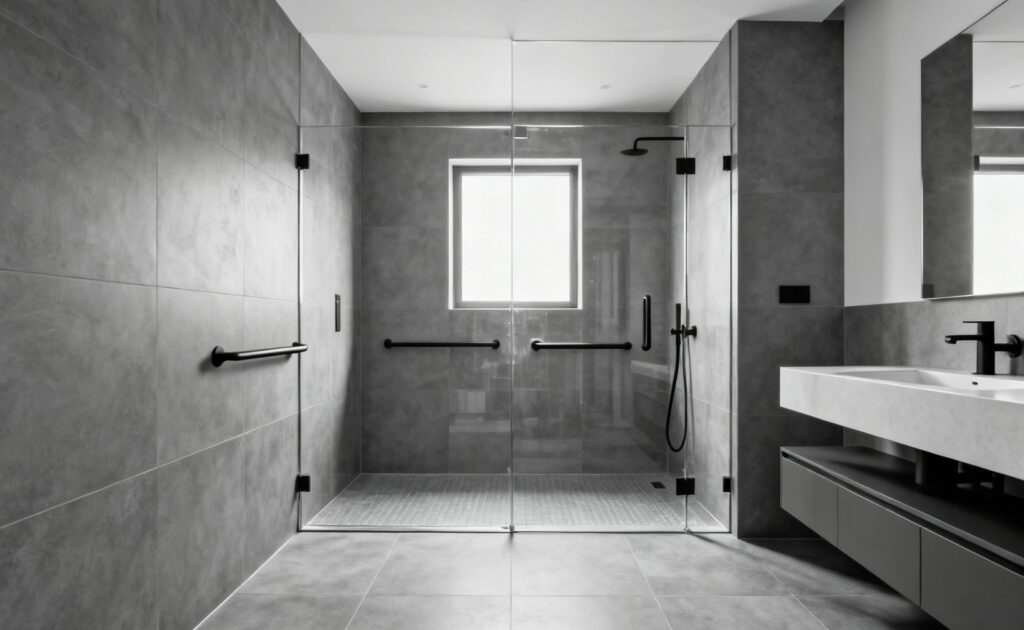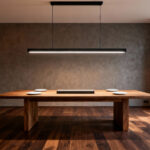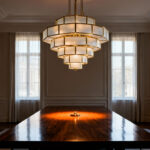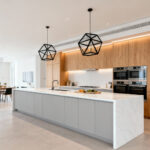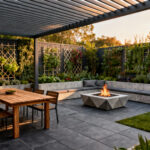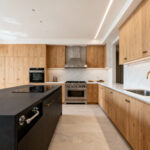Designing a home is, at its heart, an act of profound optimism—every choice reflects not just a stylistic preference, but deeper convictions about how a space should support a life well-lived. The most compelling modern bathrooms aren’t simply decorated; they are authored. They are intentional spaces that anticipate the ebbs and flows of life, creating a narrative of enduring comfort and quiet grace. These 20 principles separate a truly livable, future-proof sanctuary from a merely fashionable room.
This is where the philosophy of universal design becomes our most powerful tool. It’s the simple, yet revolutionary, idea that great design should work for everyone, regardless of age, size, or ability. We’ll explore how this compassionate approach can redefine luxury, merging sophisticated aesthetics with an uncompromising commitment to function. Forget the clinical look you might associate with accessibility; this is about crafting spaces that are both breathtakingly beautiful and deeply human.
We’ll journey from the core philosophy of inclusive design to the specific textures and materials that engage our senses. Then, we’ll engineer the space for seamless ergonomics and finally, elevate it into a personal wellness retreat through sustainable, intelligent choices. This is more than a guide—it’s a new way of thinking about the most personal room in your home, ensuring it serves you beautifully, now and for all the years to come.
Embracing Holistic Design Paradigms (Part 1)
Before we select a single tile or faucet, we must begin with a foundational shift in perspective. True modernism isn’t just about clean lines; it’s about intelligent, empathetic design that considers the whole person and the entire arc of their life. This first section is about embracing design paradigms that create spaces of genuine, lasting support and understated elegance.
1. Implement an ‘Aging in Place’ Strategy for Future-Proofed Elegance
An ‘aging in place’ strategy isn’t about planning for decline; it’s about designing for a lifetime of independence and dignity. It’s the most forward-thinking approach you can take, embedding flexibility into your home’s DNA. The goal is for safety and support to be so elegantly integrated that they are invisible, simply felt as comfort and ease. We start by choosing materials with both beauty and brains—think matte-finish, non-slip porcelain tiles that feel wonderful underfoot or stone that’s been honed for a soft, tactile quality.
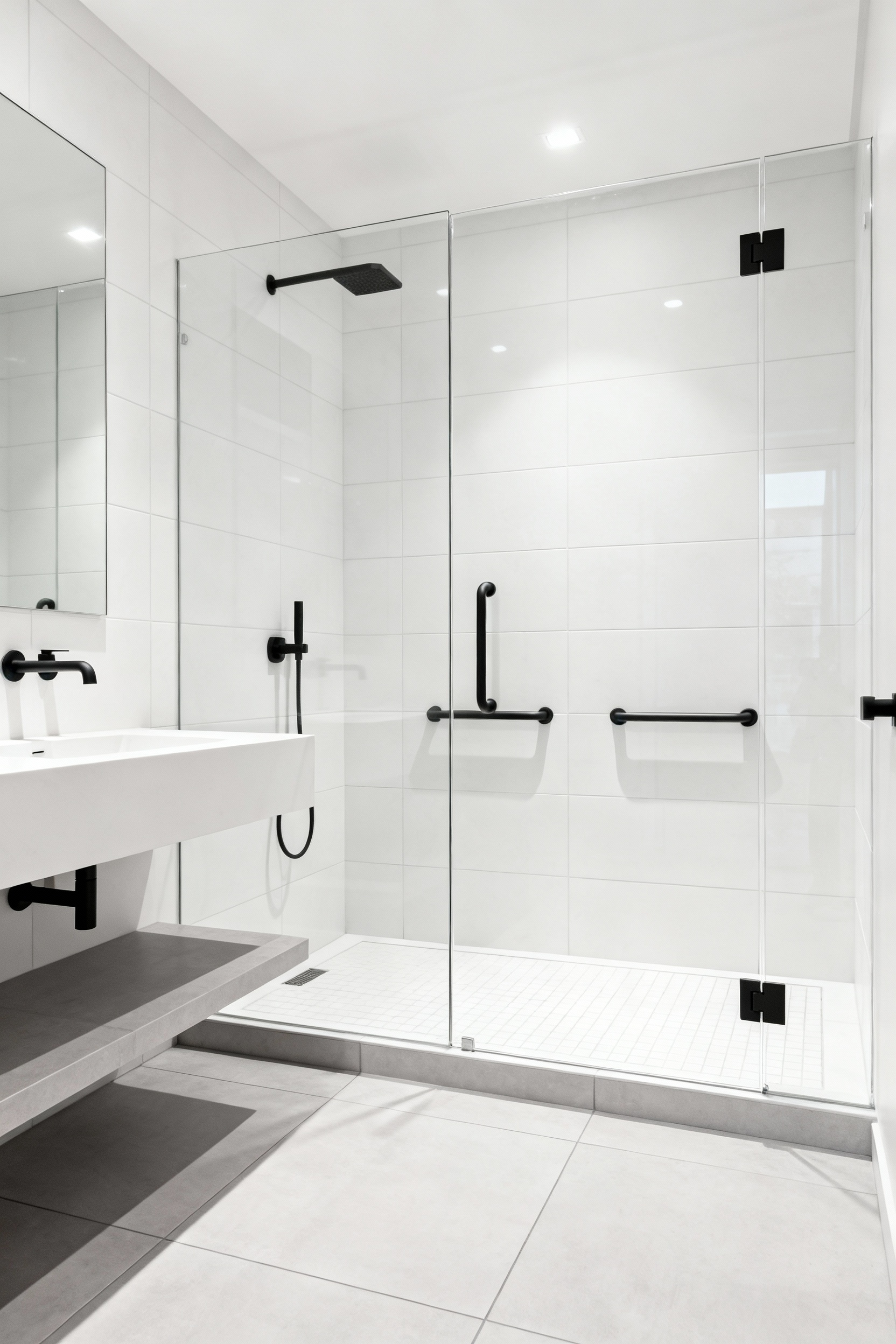
The spatial application is where this philosophy truly shines. A curbless, or zero-threshold, shower is the epitome of this principle. It creates a seamless plane that is not only visually stunning and expansive but also eliminates a common tripping hazard. Reinforcing the walls for future grab bar installation is a simple step during construction that pays dividends later, allowing you to add support exactly where you need it without a disruptive remodel. In my universal design expert practice, I often tell clients that the smartest investments are the ones no one sees—like that simple piece of plywood behind the tile that guarantees future security.
2. Harmonize the Biophilic Connection Through Integrated Natural Elements
There’s an undeniable truth we all feel: connecting with nature is restorative. Biophilic design is the intentional practice of weaving the natural world into our interiors to improve our psychological well-being. It moves beyond just placing a plant on a windowsill and instead integrates organic materials, forms, and patterns into the architecture of the space itself. Consider a vanity carved from a piece of reclaimed timber, its imperfections telling a story, or a basin shaped from a single block of river stone.
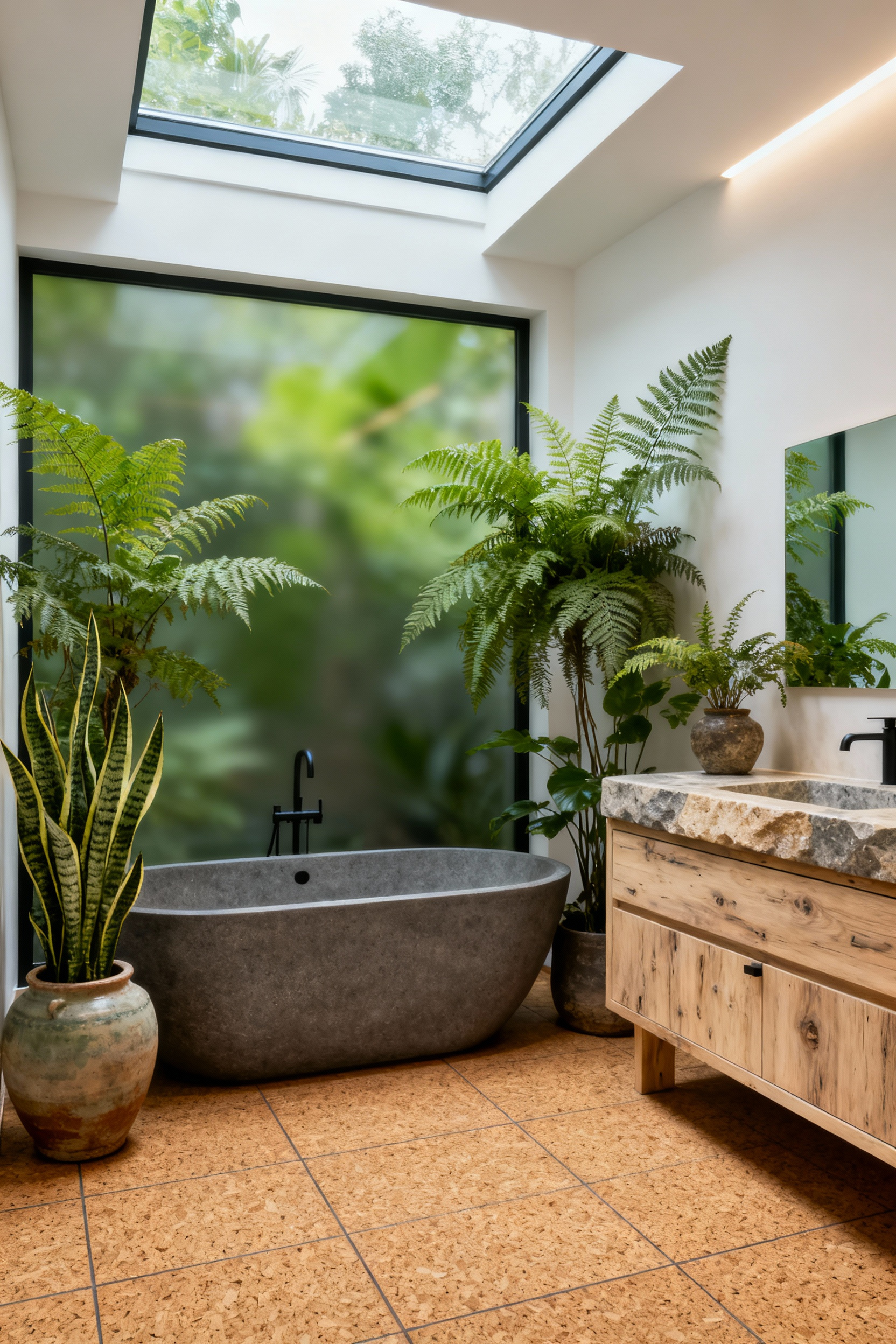
Spatially, this means maximizing every drop of natural light. Large windows, skylights, and even clerestory windows can transform a room, creating a dynamic interplay of light and shadow that shifts throughout the day. Where light is scarce, technology can mimic nature’s rhythms with tunable LEDs that transition from cool morning light to a warm evening glow. By bringing living textures, natural light, and the gentle sound of water into the bathroom, we transform it from a functional room into a true sensory escape that nurtures the soul.
3. Design with Neuro-Aesthetic Principles for Enhanced Cognitive Comfort
Our surroundings have a profound impact on our mental state. Neuro-aesthetics explores how design affects our brain, and we can leverage these principles to create bathrooms that actively reduce stress and promote calm. This starts with a palette of soft, muted colors drawn from nature—serene blues, gentle grays, and warm earth tones—that are scientifically shown to lower our heart rate. Tactile surfaces that are pleasing to the touch, like brushed metals or smoothly sanded wood, offer gentle sensory input without being overstimulating.
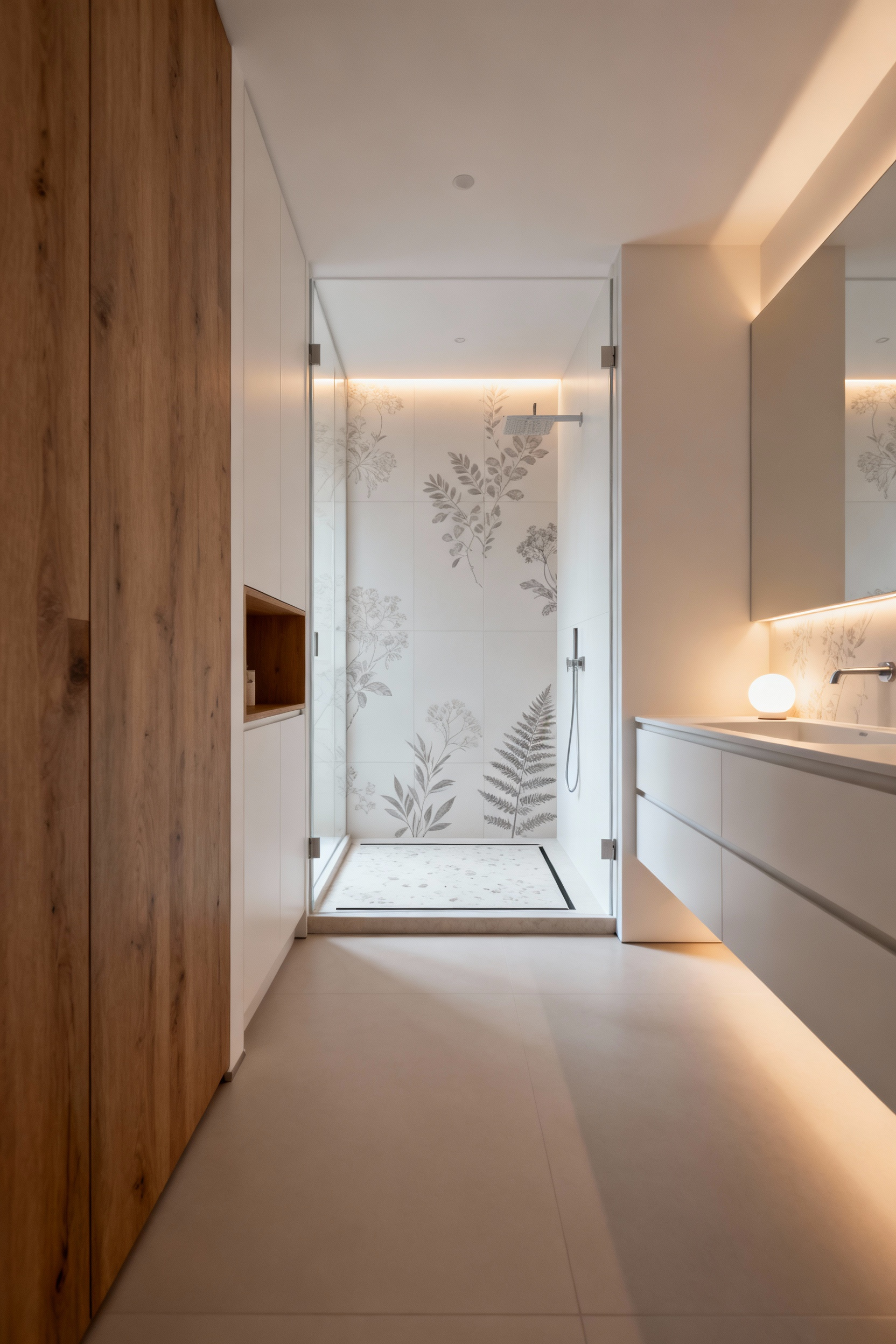
Clutter is the primary adversary of cognitive comfort. The spatial layout should champion minimalism and order, with thoughtfully designed storage ensuring everything has a home, out of sight. Rounded, organic shapes are preferred over sharp angles, as they create a subconscious feeling of safety and flow. This focus on cognitive well-being turns daily routines into mindful rituals. It’s a sophisticated approach to bathroom inspiration modern design that proves profound comfort comes from an environment that respects and calms the human mind.
4. Prioritize Fluid Movement Pathways for Unimpeded Accessibility
The elegance of a space can be measured by how effortlessly one can move through it. This principle of universal design ensures that ease of movement is a given for everyone, whether they’re a toddler, an athlete with a sports injury, or a person using a mobility aid. Material choices support this with seamless flooring—like large-format tiles with minimal grout lines—that creates a continuous, trip-free surface. It’s about more than just meeting code; it’s about creating a sense of graceful freedom.
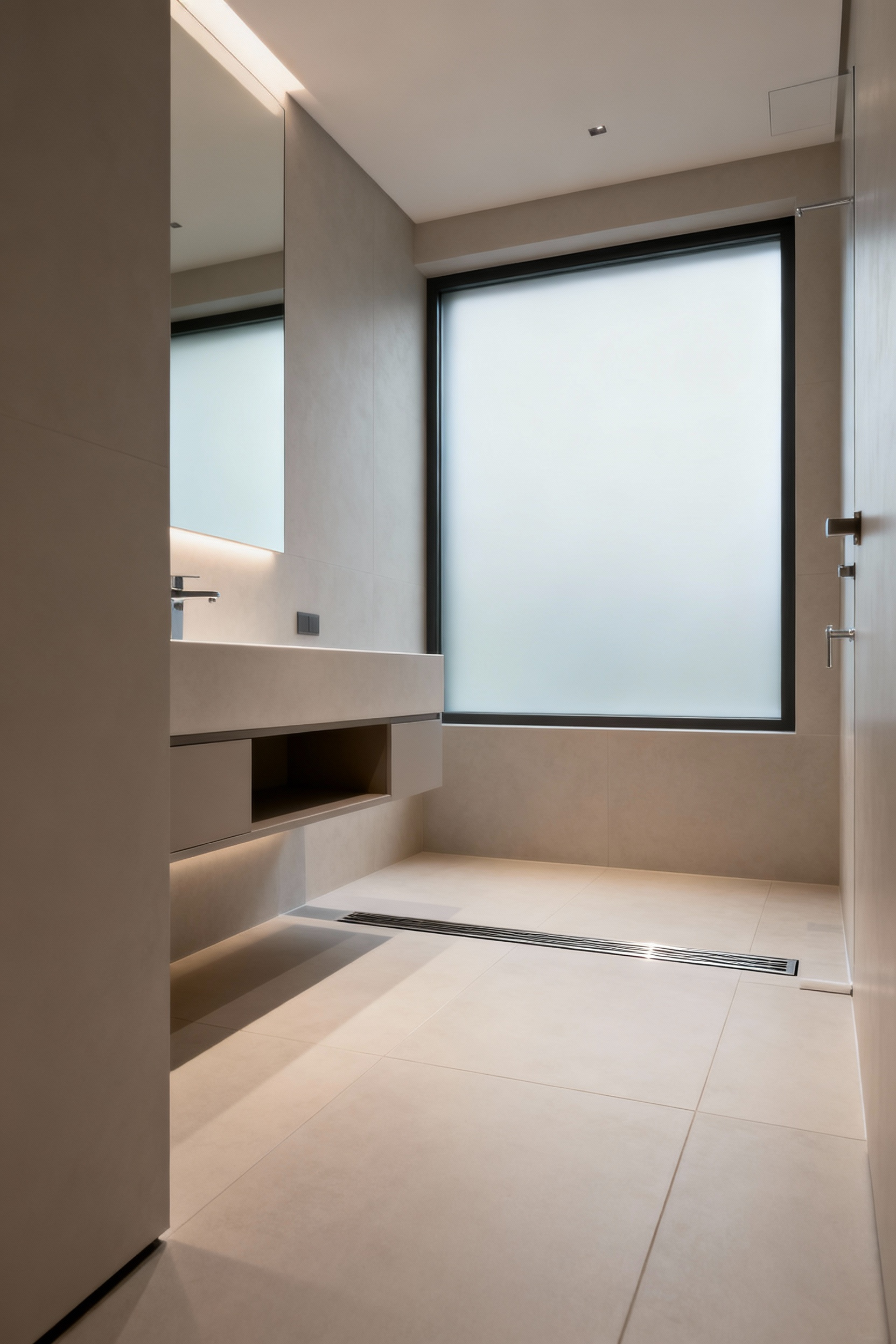
Spatially, this translates to generous clearances and open pathways. A 60-inch turning radius for a wheelchair isn’t just a requirement; it creates a wonderfully spacious and uncluttered feeling for everyone. Wall-mounting toilets and vanities frees up the floor, making the room feel larger and significantly easier to clean. It’s about designing a space where no one feels hindered or constrained. What I’ve learned from years of accessible design is that when you design for the person with the most significant needs, you almost always create a better, more functional, and more beautiful space for everyone else.
Embracing Holistic Design Paradigms (Part 2)
Building on those foundational philosophies, we now move into the art of shaping the space itself. This is where we translate abstract ideas into tangible form, planning the bathroom not as a collection of fixtures but as a holistic environment designed around a personal narrative and universal access.
5. Articulate a Bespoke Narrative Through Purposeful Space Planning
A great bathroom tells a story. It reflects the cadence of your life and supports your daily rituals, whether that’s a rushed morning preparation or a long, restorative evening soak. Purposeful space planning is the art of choreographing this story, designing distinct zones for different activities while ensuring a harmonious flow between them. It’s about thinking preemptively: Where will you place your towel so it’s within reach of the shower? Is the lighting at the vanity perfect for detailed tasks? Every square inch is considered, making the entire space feel intuitive.
This translates to material choices that subtly guide you through the space. A shift in floor texture—from smooth tile to tactile pebbles in the shower, for instance—can delineate a zone without walls. A continuous material used on both the floor and up a feature wall can expand the perceived size of the room, creating a dramatic, unified statement. This meticulous choreography is what elevates a layout from merely functional to truly exceptional, making it a cornerstone of refined bathroom inspiration modern. Ultimately, a bathroom planned with this level of intention becomes a sanctuary that feels custom-built for your life, adapting seamlessly as your needs change.
Curating Textures and Palettes for Modern Serenity (Part 1)
Now we engage the senses. The character of a modern sanctuary is defined by what we see and touch. This section focuses on the careful selection of surfaces, colors, and lighting—the elements that coalesce to create an atmosphere of profound tranquility and functional beauty.
6. Opt for Large-Format Porcelain Slabs to Diminish Grout Lines and Enhance Seamlessness
One of the most powerful moves in modern bathroom design is the pursuit of visual continuity. Large-format porcelain slabs are the ultimate expression of this idea, creating expansive, monolithic surfaces that feel both luxurious and serene. By dramatically reducing or eliminating grout lines—which are notorious for collecting grime and visually cluttering a space—you create an uninterrupted canvas that makes any bathroom feel larger and more cohesive. These slabs are incredibly durable and non-porous, making them a perfect, low-maintenance choice for a demanding environment.
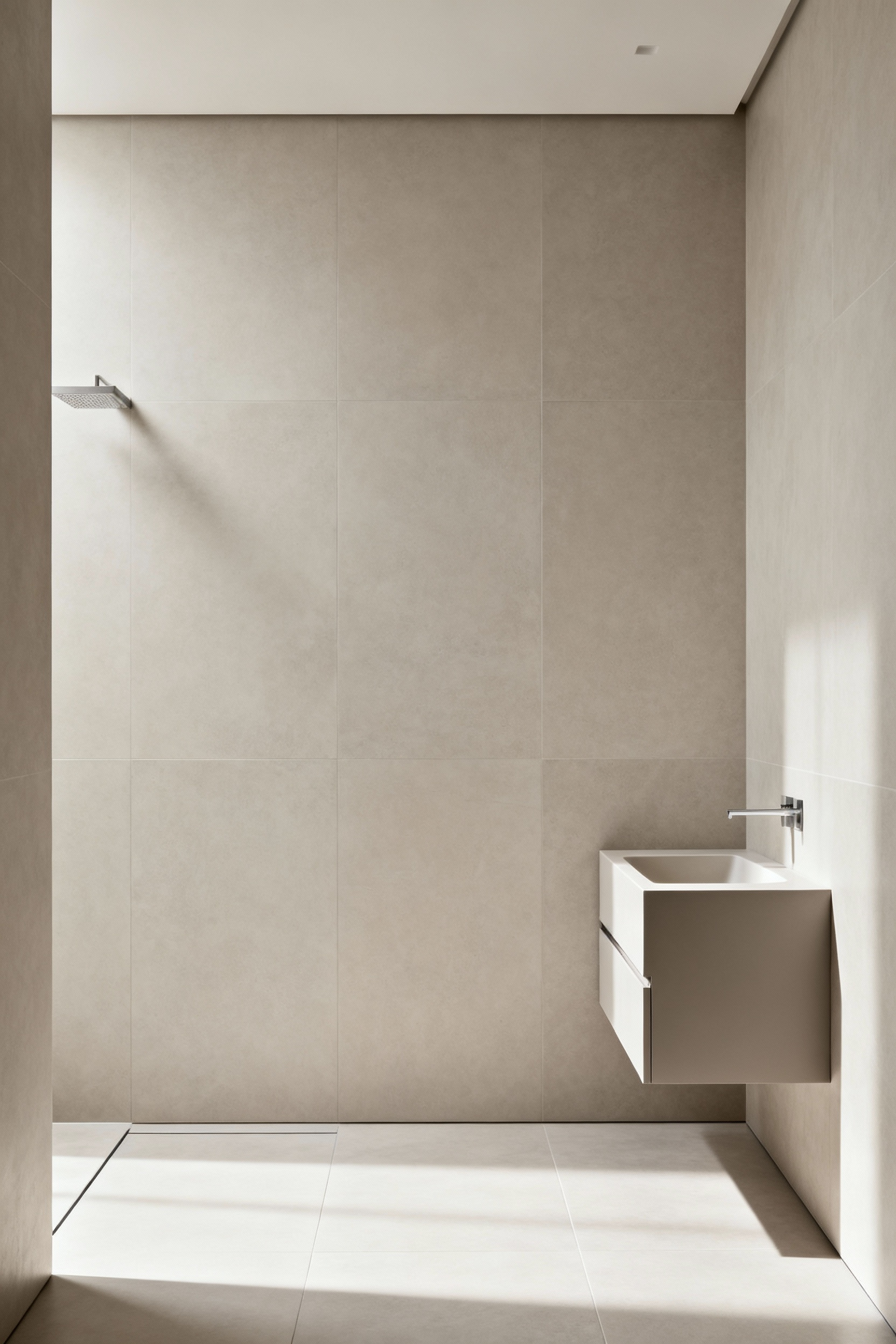
From a design perspective, their application is transformative. Imagine a walk-in shower clad in book-matched slabs where the marble-like veins flow seamlessly from one panel to the next, creating a single, stunning piece of art. Using the same material on the floor and walls forges a harmonious envelope that is both visually arresting and deeply calming. What really gets me about this approach is how it simplifies the visual field, allowing your mind to relax. It turns the walls and floor from a collection of tiles into a singular, architectural statement. This creates a sense of order and peace, turning a daily routine into a much more meditative experience.
7. Integrate Textured Natural Stones for Tactile Depth and Organic Sophistication
While seamless surfaces provide a serene backdrop, textured natural stones introduce soul and tactile warmth. This is about balancing modern sleekness with the raw, honest beauty of materials from the earth. Integrating elements like a honed basalt floor that absorbs light, or a feature wall of fluted marble that plays with shadow, prevents the space from feeling sterile. It invites touch and fosters a deeper connection to the environment.
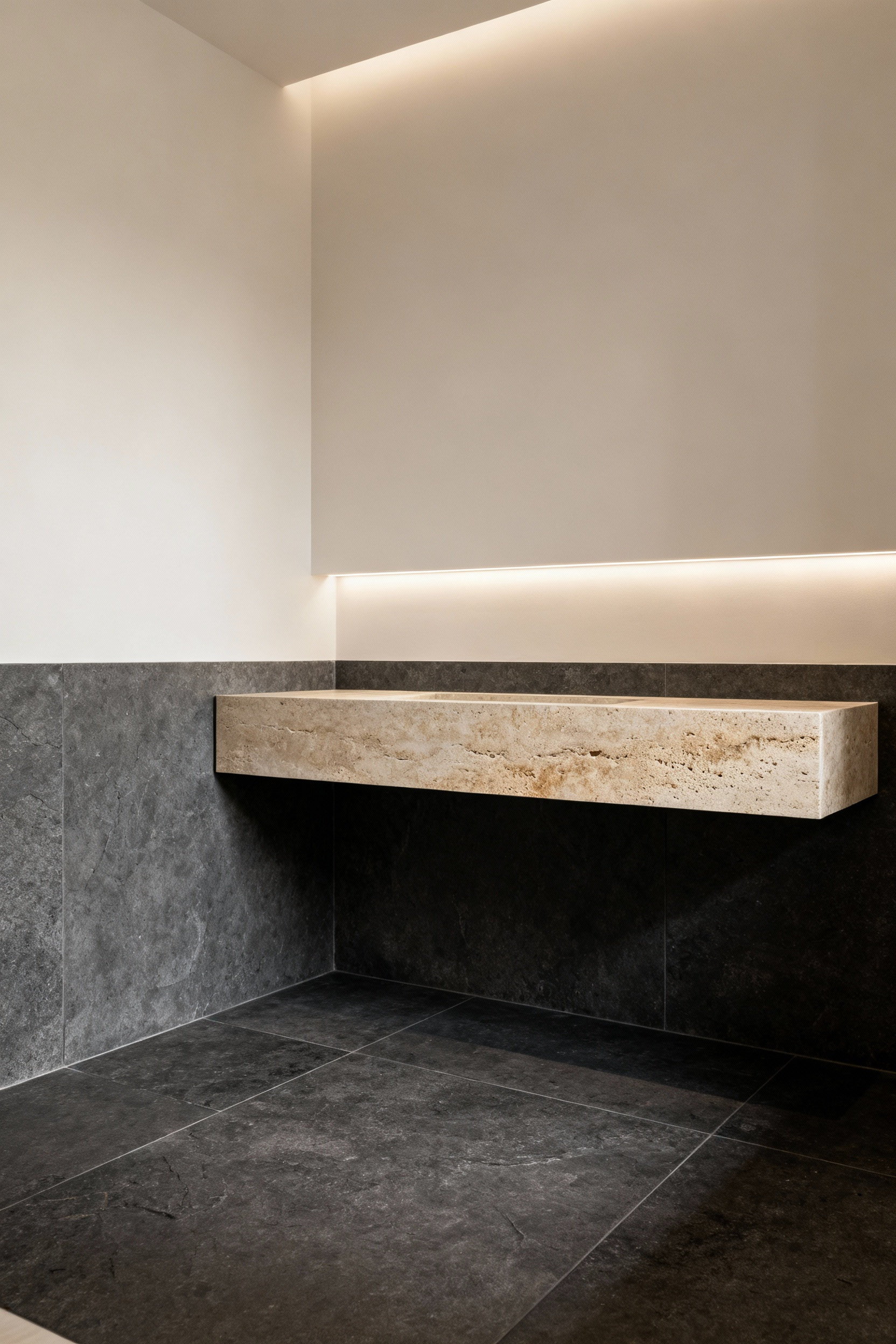
These textured stones are best used as focal points to create moments of contrast and sensory delight. A shower floor laid with smooth river pebbles offers a gentle massage underfoot, grounding you in the moment. A rough, chiseled edge on a travertine vanity top provides a visceral, organic counterpoint to the smooth fixtures. I’ve seen this work best when a single, powerful textured element is allowed to become the hero of the room, adding a layer of organic richness that feels both ancient and utterly contemporary. It’s this dialogue between the raw and the refined that defines a truly sophisticated space.
8. Leverage Dynamic LED Illumination for Adaptive Ambience Control
Light is arguably the most important, and often most overlooked, design material we have. Dynamic LED lighting transforms the bathroom from a static room into an adaptive environment, capable of shifting its mood to suit your needs. It’s about recognizing that the bright, invigorating light needed for a morning shave is entirely wrong for a relaxing evening bath. Today’s technology makes this control incredibly intuitive.
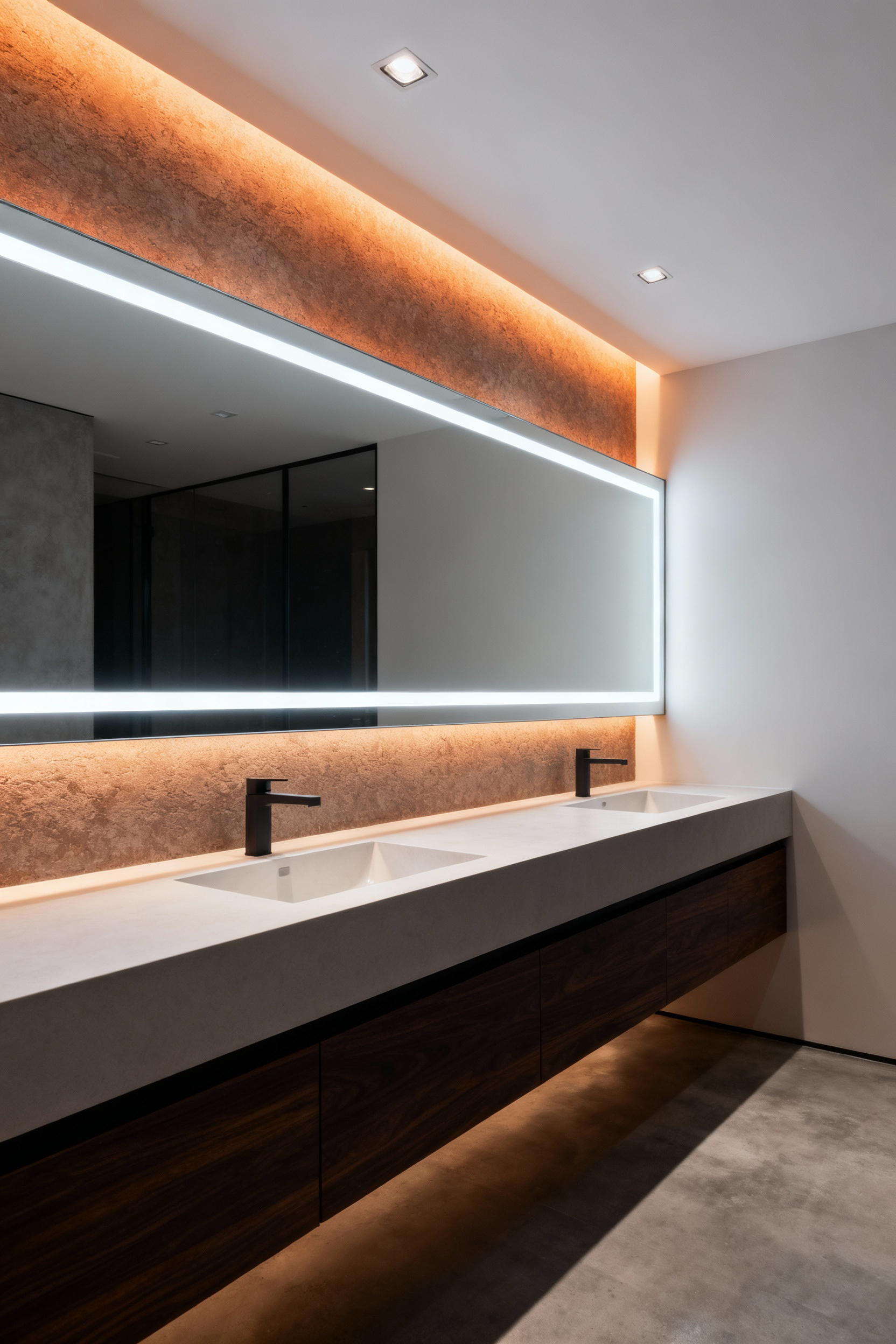
The key is a layered approach. Ambient lighting, often from hidden coves or backlit mirrors, provides a soft, overall glow. Task lighting at the vanity must be clear and shadow-free. And accent lighting can be used to highlight a beautiful texture or architectural detail. With tunable white LEDs, you can adjust the color temperature—from a cool, energizing blue-white to a warm, candle-like amber—and dim the intensity to create the perfect atmosphere for any moment. This ability to control the lighting empowers you to curate your experience, transforming the bathroom into a responsive sanctuary that supports your well-being.
9. Employ a Refined Monochromatic Palette with Strategic Accents for Visual Tranquility
A monochromatic color scheme is a powerful tool for creating a serene and sophisticated space. It’s an exercise in restraint, allowing form, texture, and light to become the stars of the show. Instead of relying on varied colors, depth is created through subtle shifts in tone and finish—the way a matte surface absorbs light compared to a glossy one, or how a brushed metal fixture contrasts with a honed stone counter.
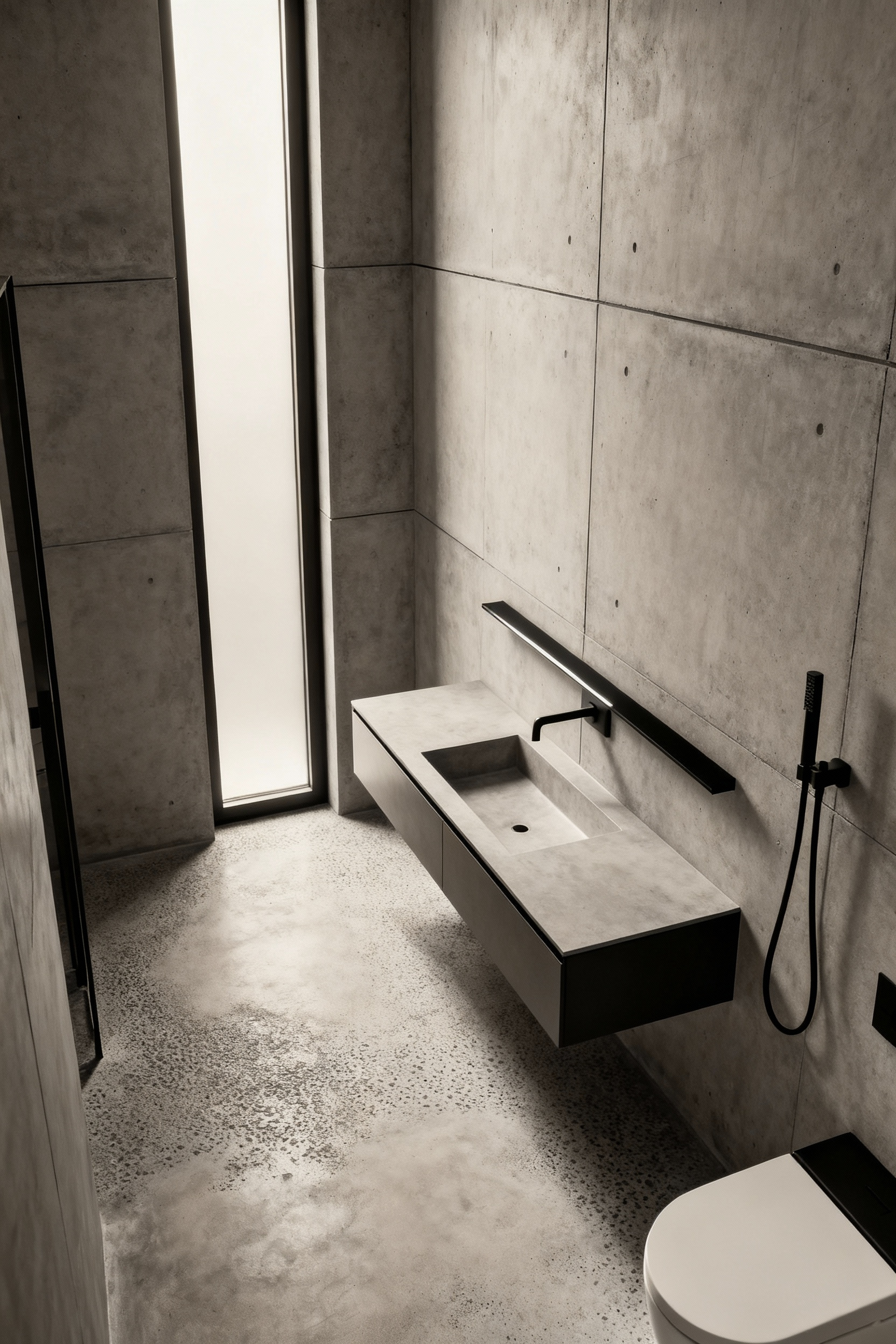
This enveloping approach creates a visually quiet and expansive backdrop. A strategic accent—whether it’s the deep green of a lacquered vanity, the warm glow of a brass faucet, or a single piece of vibrant art—then carries immense impact. Its power is magnified by the calm that surrounds it. From my work in accessible design, I’ve noticed that a well-executed monochromatic palette with high-contrast fixtures is also incredibly helpful for those with low vision. It proves that thoughtful, beautiful design can inherently be more inclusive, achieving visual tranquility and functional clarity at the same time.
Curating Textures and Palettes for Modern Serenity (Part 2)
Our choices have consequences that extend beyond the four walls of a room. This section is about deepening our commitment to modern serenity by selecting materials that are not only beautiful but also healthy for ourselves and for the planet. It’s where aesthetics and ethics converge.
10. Select Low-VOC, Sustainably Sourced Finishes for Health and Environmental Integrity
The ultimate luxury is a healthy home. Selecting low-VOC (Volatile Organic Compound) finishes is a non-negotiable step in creating a bathroom that actively contributes to your well-being. VOCs are harmful chemicals off-gassed from many common paints, sealants, and adhesives, negatively impacting indoor air quality. Choosing zero or low-VOC options ensures the air you breathe in your personal sanctuary is clean and pure. This commitment to health should extend to sustainably sourced materials, from FSC-certified woods for cabinetry to recycled glass tiles.
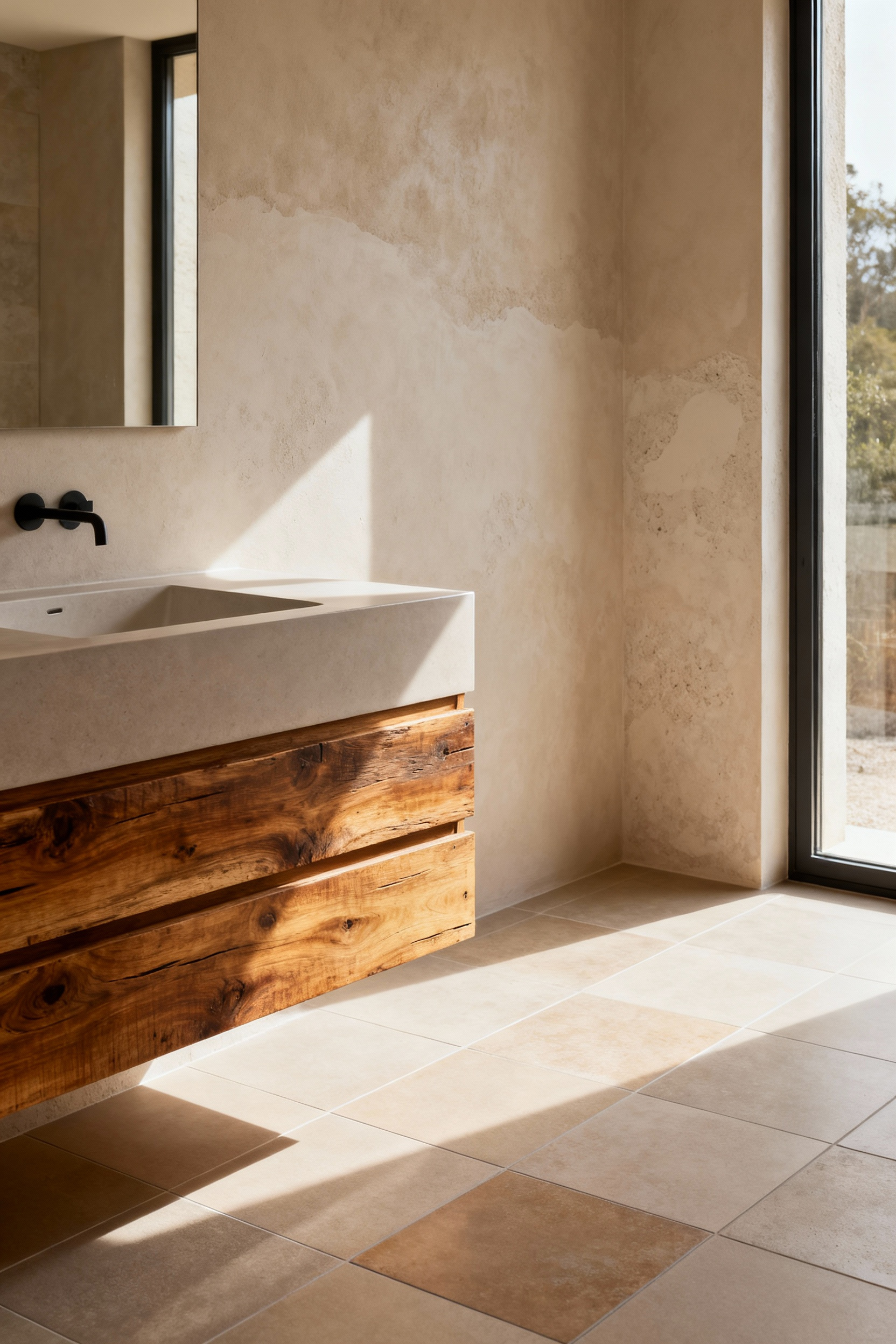
These choices are not a compromise on style; in fact, they often lead to more beautiful and authentic outcomes. A solid wood vanity made from reclaimed timber has a character and story that mass-produced particleboard could never replicate. The subtle variations in a recycled glass tile can create a surface with incredible depth and luminosity. Integrating these finishes transforms your bathroom into a space that feels good on every level. It’s a statement that your well-being and the health of the planet are integral to your definition of luxury, making it a cornerstone of truly modern bathroom inspiration.
Engineering Ergonomics and Seamless Functionality (Part 1)
Here, we shift our focus to the intelligent engineering that makes a modern bathroom feel effortless. This is about more than just aesthetics; it’s about creating a space that works in perfect harmony with the human body, where every interaction is intuitive, comfortable, and seamless.
11. Configure Zoned Lighting Schemes to Enhance Task Efficacy and Mood Setting
We’ve discussed adaptive lighting, but zoned lighting takes it a step further. It’s the practice of creating distinct lighting environments for different areas of the bathroom, recognizing that the vanity, shower, and toilet area all have different needs. A single overhead light simply can’t do it all; it creates harsh shadows at the mirror and feels institutional. Instead, a well-designed bathroom layers multiple light sources, each with a specific job.
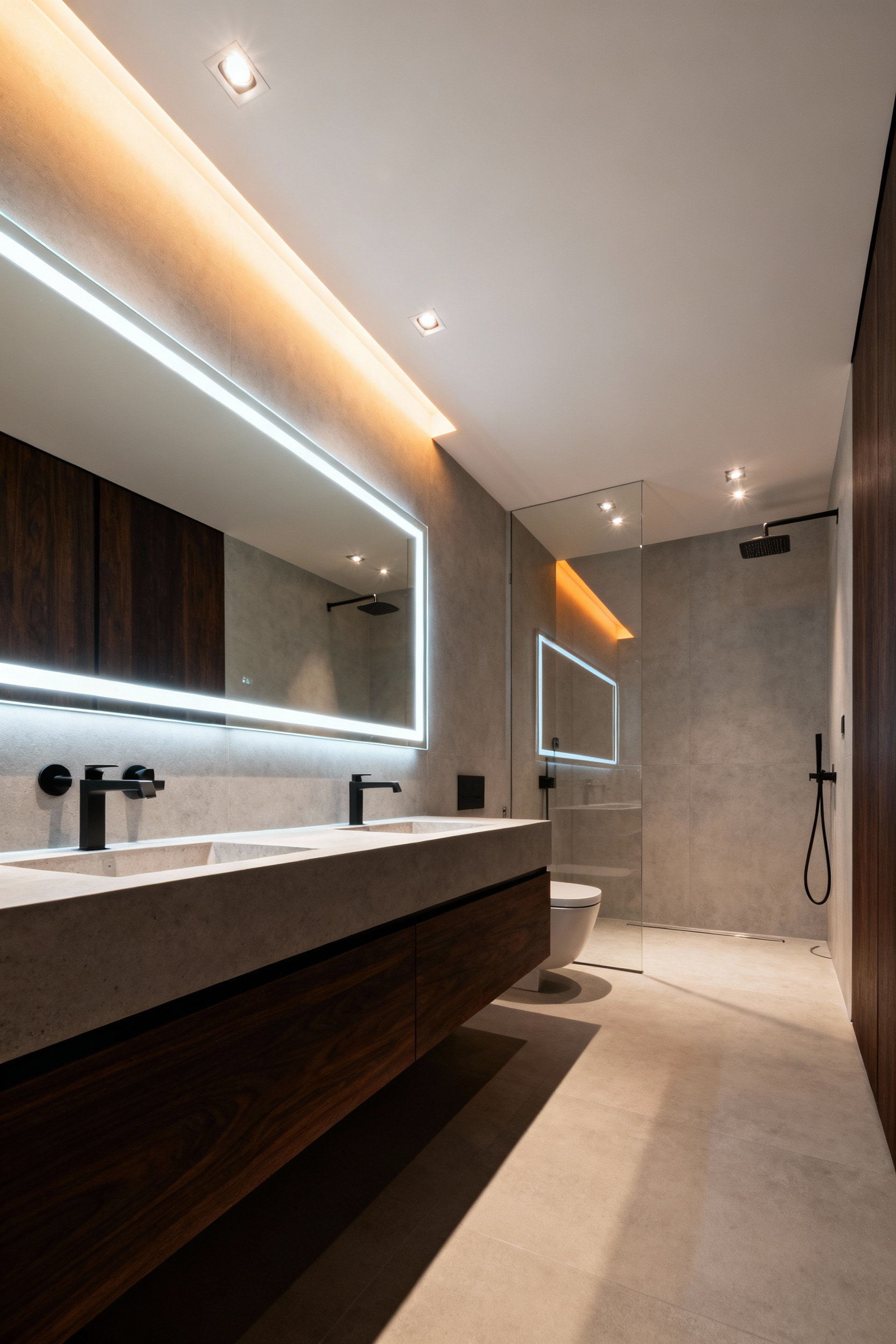
At the vanity, vertical lights or sconces on either side of the mirror provide the best, shadow-free illumination for grooming. In the shower, a waterproof recessed light ensures safety and clarity. A low-level, motion-activated light near the toilet is perfect for navigating at night without jarring your senses. When these zones are on separate, dimmable controls, you gain complete mastery over the space. I’ve noticed in my practice that a great lighting plan is one of the most transformative elements in any design. It can make a small room feel grand and a simple room feel luxurious, proving that intelligent design is often about controlling the intangible.
12. Integrate Smart Technology for Hands-Free Operation and Personalized Comfort
Smart technology in the bathroom should be about making life simpler, healthier, and more comfortable. It’s not about tech for tech’s sake, but about thoughtful integrations that feel intuitive. Motion-sensor faucets are a great example—they reduce the spread of germs and conserve water without you even having to think about it. Smart toilets with integrated bidets, heated seats, and hands-free flushing elevate hygiene and comfort to a new level.
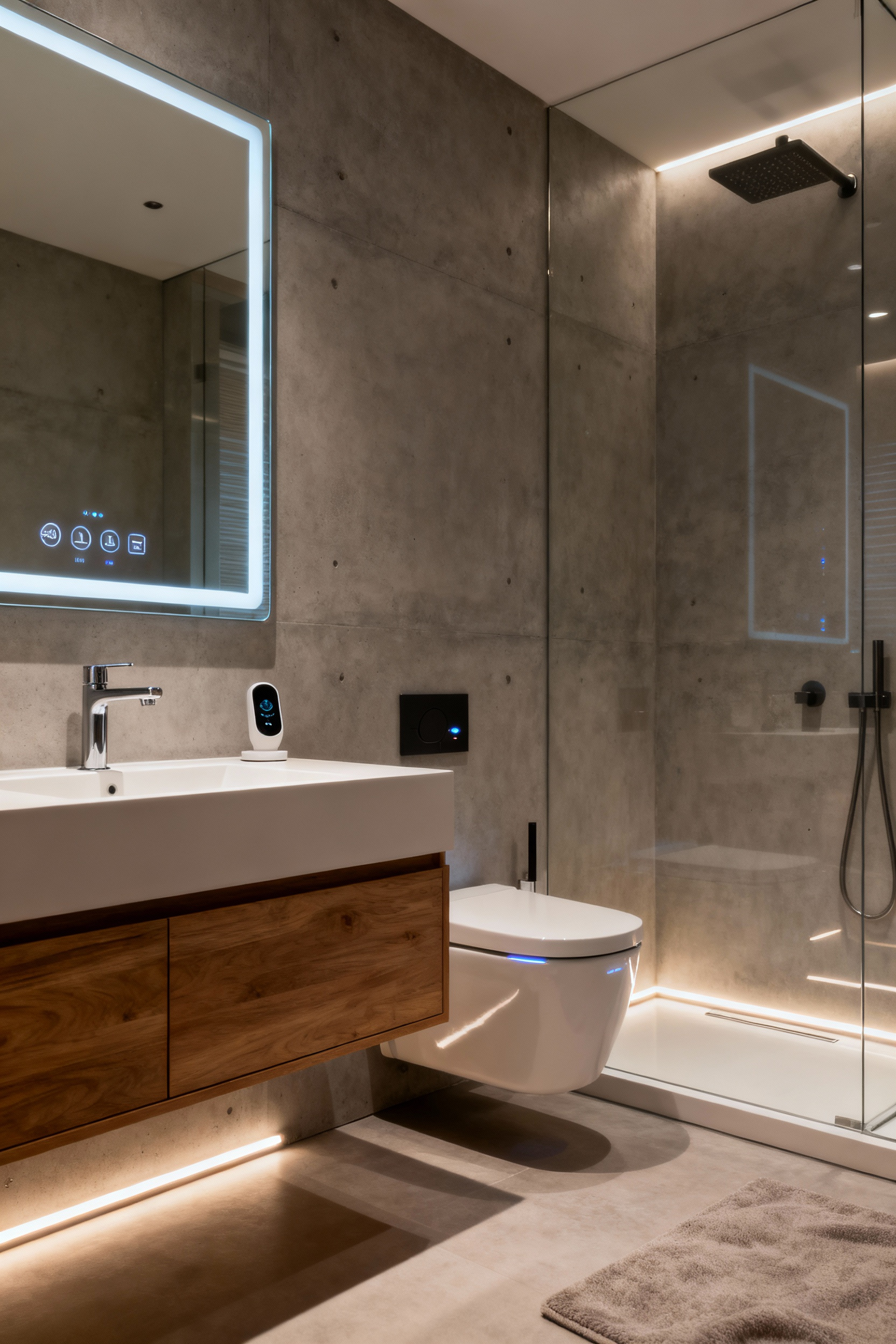
A digital shower system that remembers your exact temperature and pressure preferences can turn a routine shower into a personalized spa experience. Smart mirrors that de-fog automatically or display the time and weather can streamline your morning routine. The key is for this technology to be seamlessly integrated, enhancing the experience without cluttering the aesthetic. It should feel like magic—present in its benefit, but invisible in its form—to truly elevate modern bathroom inspiration.
13. Conceal Utility Elements Behind Integrated Cabinetry for Visual Cohesion
The essence of a serene bathroom is visual simplicity. Nothing disrupts that feeling of calm faster than exposed plumbing, cluttered toiletries, or visible waste bins. A hallmark of sophisticated design is the artful concealment of these utilitarian necessities behind clean, integrated cabinetry. This creates an uninterrupted visual plane that feels calm, organized, and intentional.
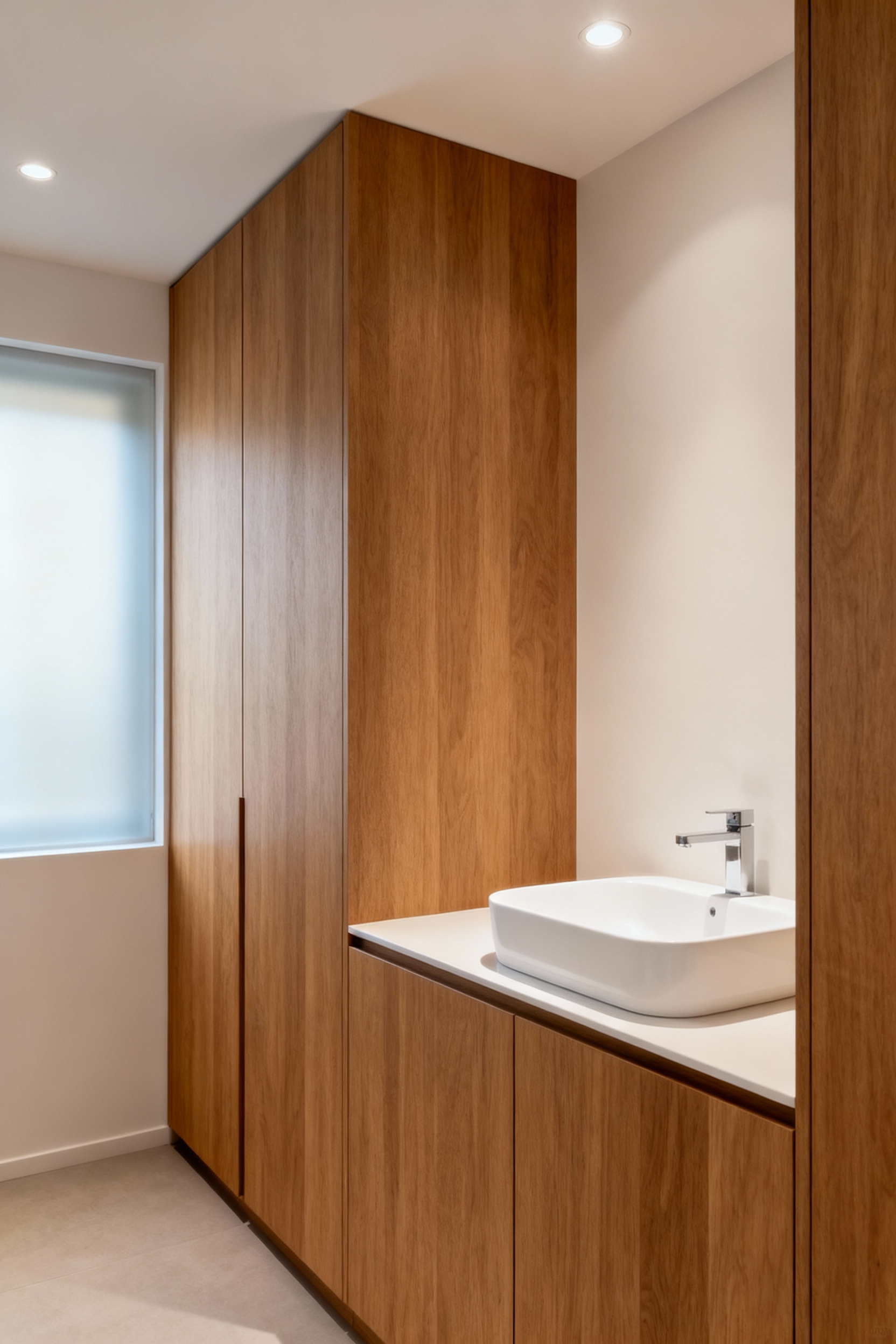
This is achieved through clever, bespoke solutions. Plumbing for a wall-mounted toilet is hidden within the wall. Electrical outlets are placed inside drawers or medicine cabinets to power toothbrushes and shavers out of sight. A tilt-out cabinet can discreetly house a laundry hamper or waste receptacle. I learned this when designing a compact bathroom for a client with limited mobility: concealing everything not only made the space feel twice as large and far more peaceful, but the integrated storage made essentials much easier and safer for them to access. It’s a perfect example of how clean aesthetics and practical function can—and should—go hand in hand.
14. Specify Wall-Mounted Fixtures for Unobstructed Floor Space and Easier Maintenance
Lifting fixtures off the floor is one of the most effective strategies for creating a sense of spaciousness and modern elegance. A wall-mounted, or “floating,” vanity and a wall-hung toilet instantly make a bathroom feel lighter and more open by revealing the entire floor plane. This creates an uninterrupted visual flow that can make even a small bathroom feel significantly larger.
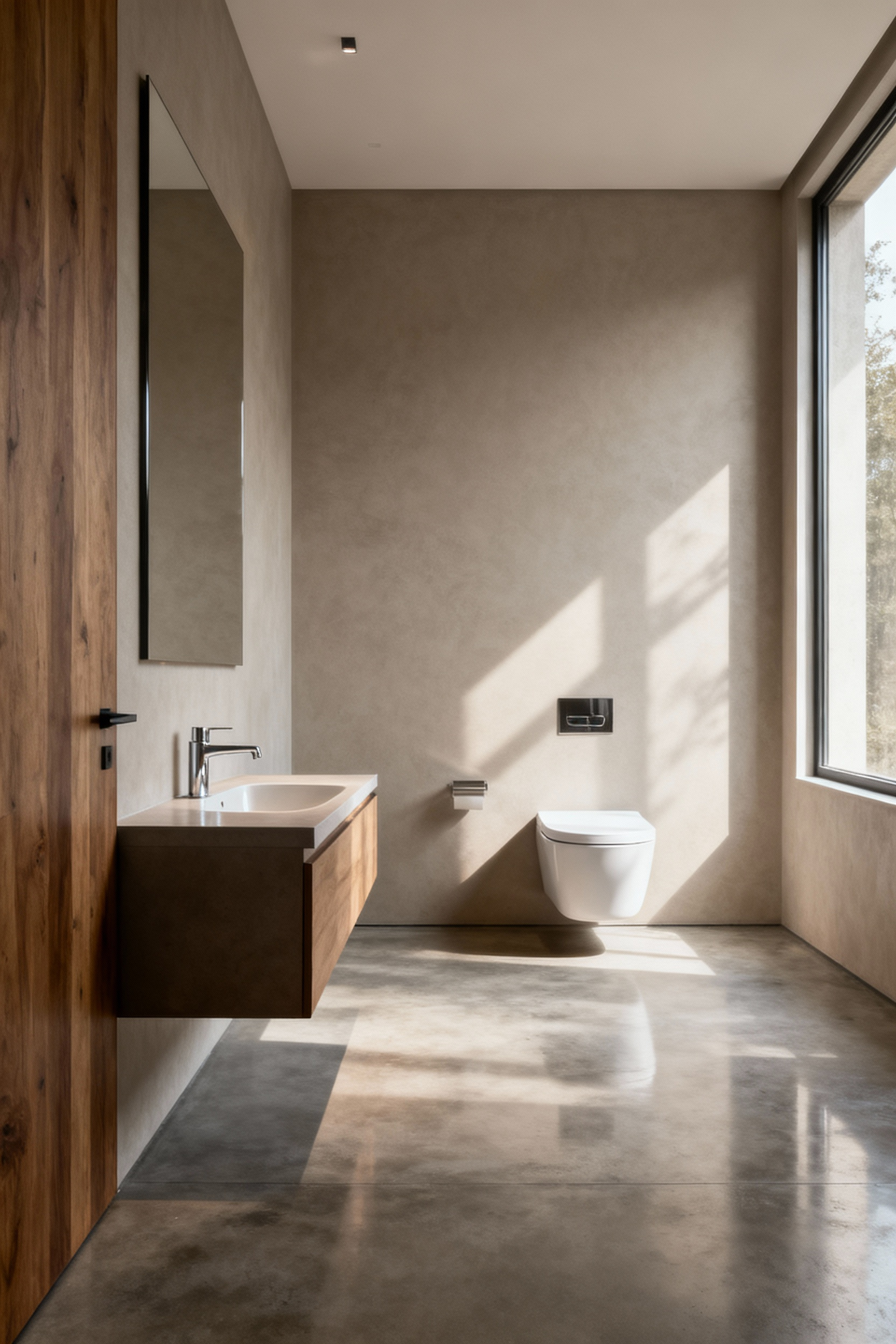
The lifestyle benefit is just as powerful. Cleaning the bathroom becomes incredibly simple when you can easily sweep or mop underneath every fixture. There are no awkward corners or pedestals to trap dust and grime, which promotes a much higher level of hygiene. From a universal design perspective, this clear floor space is also a huge advantage for anyone using a walker or wheelchair, providing crucial maneuverability. It’s a design choice that delivers a powerful trifecta of benefits: enhanced aesthetics, easier maintenance, and improved accessibility.
Engineering Ergonomics and Seamless Functionality (Part 2)
Our final exploration in engineering focuses on adaptability. The most intelligent spaces are not static; they are designed to evolve with us. This is about embedding flexibility into the very fabric of the bathroom, ensuring it remains as functional in twenty years as it is today.
15. Design with Modular Storage Systems to Accommodate Evolving Needs
Life is not static, and your storage shouldn’t be either. Designing with modular systems is a profoundly forward-thinking approach that allows your bathroom to adapt as your needs change. A young couple’s needs are very different from a family with small children, or from an older individual who requires everything to be easily accessible. Modular storage, with its adjustable shelves, configurable drawer inserts, and movable components, provides that essential flexibility.
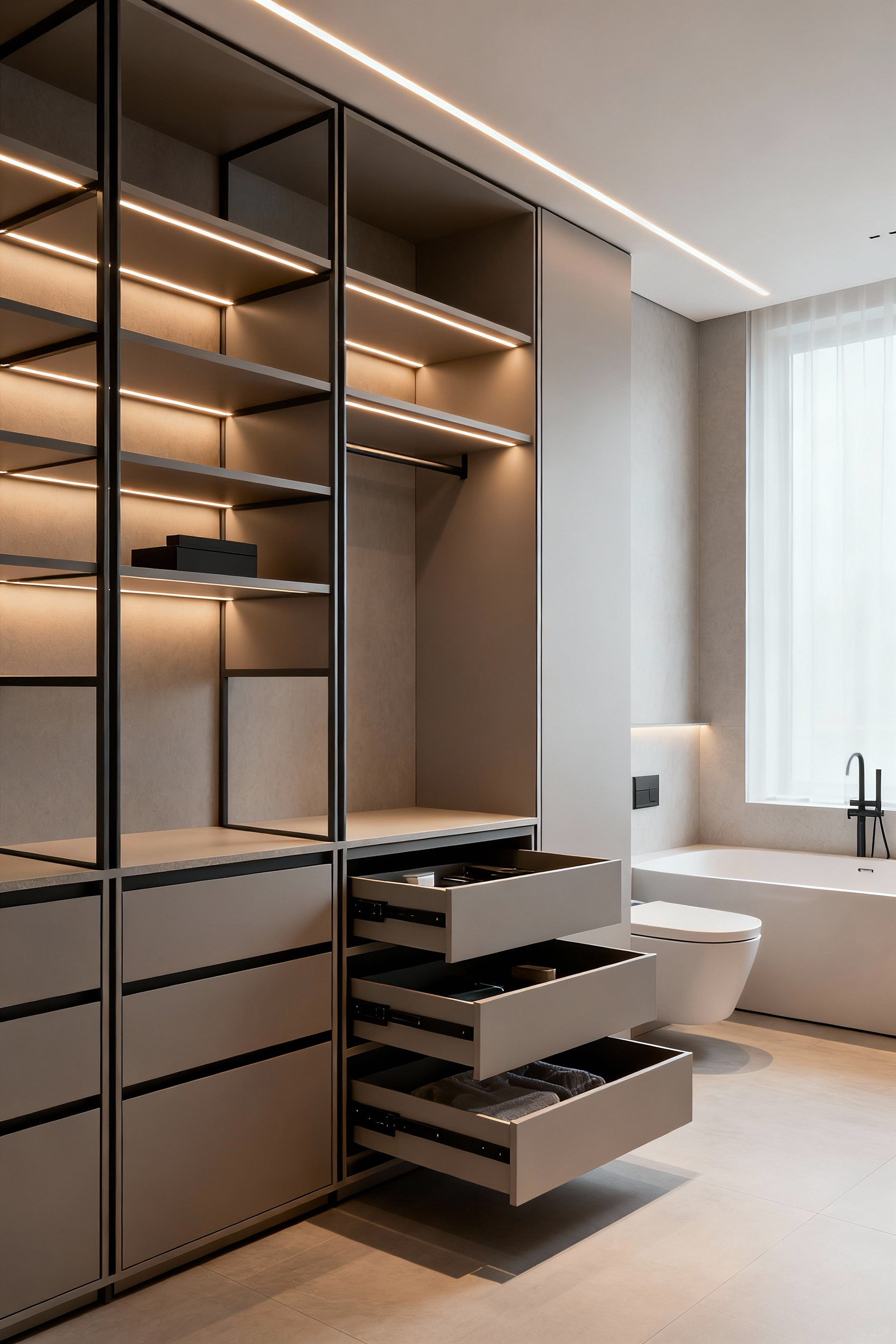
Instead of fixed cabinetry, imagine vanity drawers with customizable dividers that can be rearranged to hold different items. Think of a system of sleek, wall-mounted boxes and shelves that can be added to or reconfigured over time. This approach ensures your bathroom remains organized and clutter-free through every stage of life, without requiring a major renovation. What I tell my clients and readers is this: the most sustainable design is the one you don’t have to change. Building in this kind of adaptability from the start is the key to creating a truly timeless and functional space.
Elevating Wellness and Sustainable Luxury (Part 1)
In this penultimate section, we explore how a bathroom can transcend function to become a true center for wellness. This is where advanced concepts in personal health meet a commitment to sustainability, creating spaces that actively nurture both the individual and the environment.
16. Incorporate Smart Water Systems for Optimized Conservation and Performance
True modern luxury is inseparable from sustainability. Smart water systems embody this principle, using technology to optimize performance while drastically reducing consumption. This isn’t about sacrificing a powerful shower; it’s about making that experience more efficient and intelligent. Systems that recirculate water while it heats up save gallons every day. Faucets and showers with digital controls allow for precise temperature and flow settings, eliminating waste and providing a perfectly consistent experience.
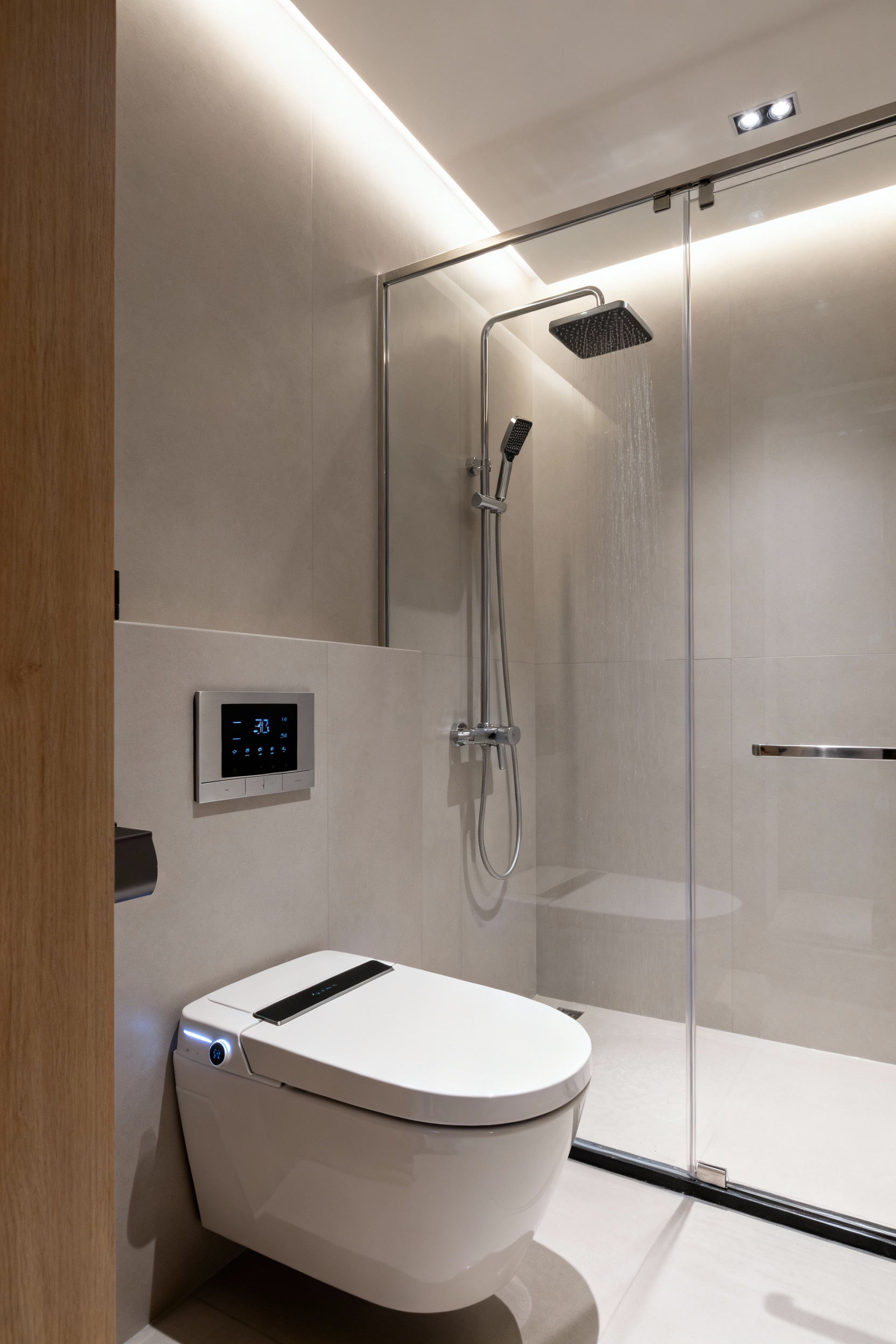
Look for fixtures with high-efficiency ratings and smart toilets that use the optimal amount of water for each flush. Some systems even include leak detection, alerting you to a problem before it causes damage and wastes resources. These technologies work silently in the background, allowing you to enjoy uncompromised performance while knowing you’re minimizing your environmental impact. It’s the seamless integration of responsibility and indulgence, a core tenet of sophisticated bathroom inspiration.
17. Establish a Dedicated ‘Mindfulness Zone’ with Aromatherapy and Sonic Integration
We can intentionally design our bathrooms to be spaces for mental and emotional restoration. Designating a specific ‘mindfulness zone’—perhaps around a deep soaking tub or within a steam shower—can transform your routine into a therapeutic ritual. This is achieved by engaging multiple senses. Integrated aromatherapy diffusers can release calming essential oils at the touch of a button, while discreet, waterproof speakers can play calming soundscapes or guided meditations.
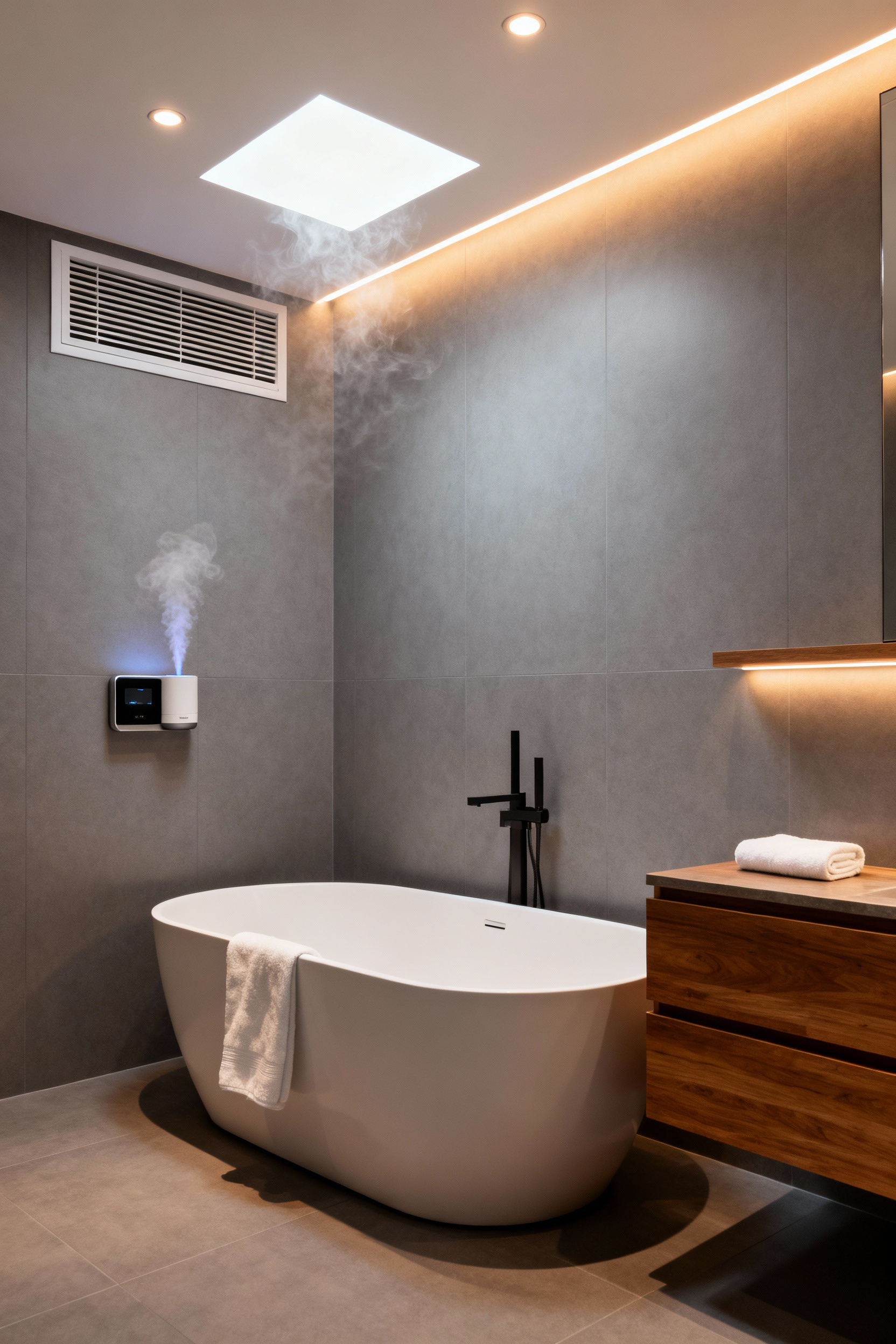
The design of this zone should support its purpose, favoring uncluttered surfaces, natural materials, and soft, dimmable lighting. It’s about creating a personal retreat where you can disconnect from the stresses of the day and reconnect with yourself. I’ve seen clients install a small, heated bench in their steam shower that has become their most cherished spot in the house—a place for five minutes of quiet contemplation. This elevates the bathroom from a place for hygiene to a vital tool for holistic well-being.
18. Optimize Natural Light Influx with Strategically Placed Glazing or Solatubes
Natural light is a powerful, free, and essential element for well-being. Optimizing its presence in a bathroom can make the space feel healthier, larger, and more alive. This goes beyond simply adding a window. It’s about strategic placement—a tall, narrow window that maintains privacy while flooding a corner with light, or a skylight perfectly positioned over a shower to create an experience of showering in the open air.
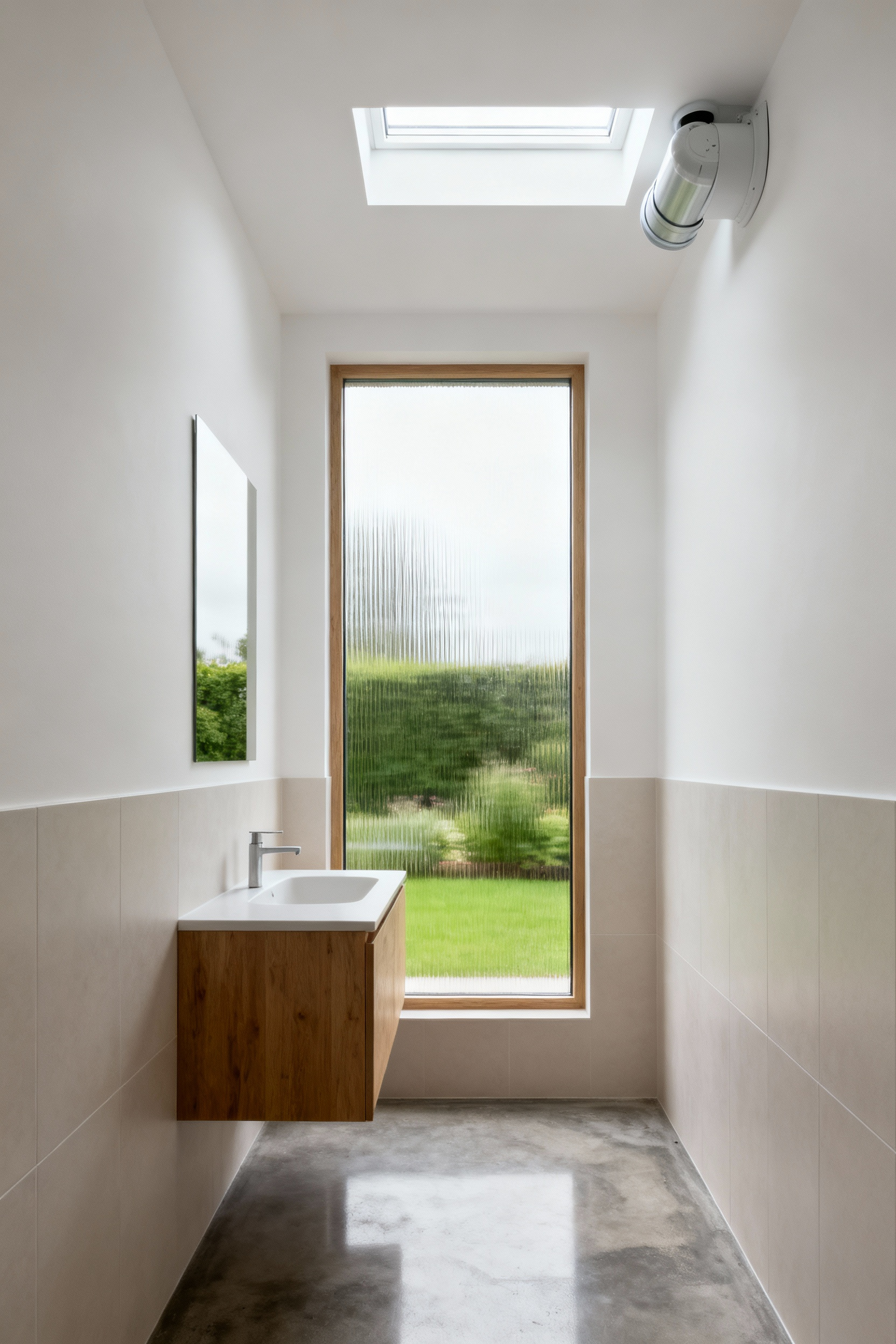
For windowless bathrooms, tubular daylighting devices, like Solatubes, are a brilliant solution. They capture sunlight from the roof and channel it down through a highly reflective tube, delivering bright, natural light to even the most interior spaces. This reduces the need for artificial lighting during the day, saving energy and connecting you to the natural rhythm of the outdoors. Bathing a bathroom in natural light is one of the simplest yet most profound ways to enhance its atmosphere and your experience within it.
19. Select Durably Engineered Fixtures for Longevity and Reduced Lifecycle Impact
The most sustainable choice is the one you only have to make once. Opting for high-quality, durably engineered fixtures is an investment in longevity that pays dividends for both you and the planet. This means looking beyond surface aesthetics to the internal components: solid brass construction over plated plastic, ceramic disc cartridges in faucets that prevent drips for decades, and tough PVD finishes that resist scratching and tarnishing.
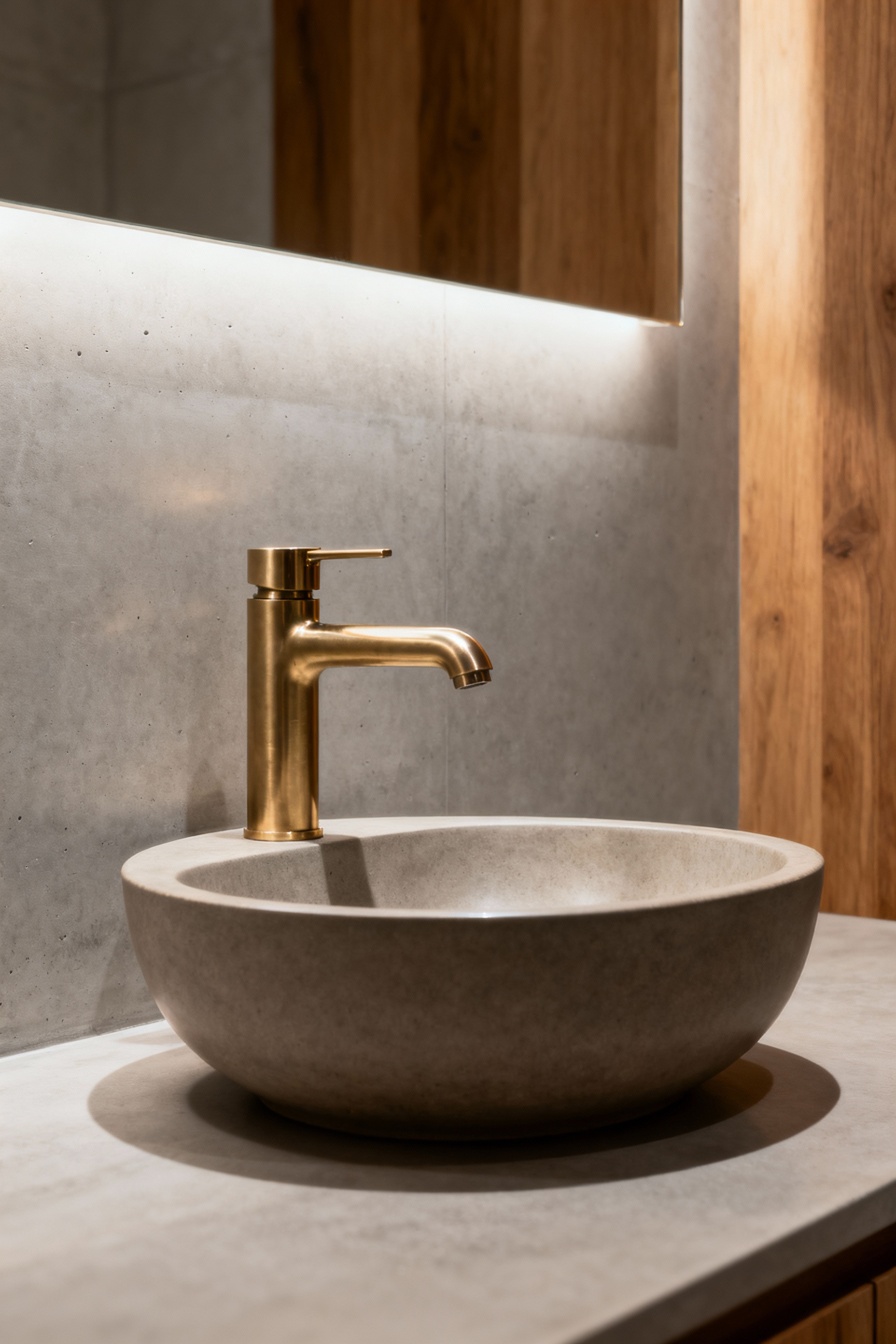
Choosing fixtures from reputable brands that stand behind their products with long-term warranties ensures you are getting something built to last. This ‘buy it once, buy it right’ philosophy actively reduces waste by minimizing the need for replacements. It’s a quiet form of activism that aligns with a more conscious, less disposable lifestyle. It’s a core principle for enduring bathroom inspiration modern designers embrace—proof that timeless quality is the ultimate luxury.
Elevating Wellness and Sustainable Luxury (Part 2)
Our final principle looks deep within the walls, focusing on the hidden infrastructure that supports future wellness innovations. This is the ultimate act of foresight, ensuring your sanctuary remains at the forefront of health and comfort for years to come.
20. Future-Proof the Plumbing Infrastructure for Advanced Bidet and Hydrotherapy Integration
The most intelligent design thinks ahead. Future-proofing your bathroom’s plumbing is a critical step in ensuring it can adapt to emerging wellness technologies without a costly and disruptive renovation. This means planning for more than just your immediate needs. Installing a dedicated electrical outlet near the toilet, for instance, makes adding a smart bidet seat a simple plug-and-play affair down the line.
When renovating, consider running larger supply lines to accommodate future hydrotherapy showers or steam generators that require higher water flow. Planning this foundational infrastructure from the start is a small investment that keeps your options open. It ensures that as wellness technology evolves, your personal sanctuary can evolve with it, cementing its value and ensuring it continues to support your health and well-being for decades. This invisible preparation is the secret to a truly timeless and intelligent modern bathroom.
Conclusion
We’ve journeyed through twenty principles, moving from broad philosophy to the finest details, and a single, powerful idea connects them all: a modern bathroom should be a testament to mindful living. It is a space designed with foresight, empathy, and a deep respect for the human experience. The true essence of bathroom inspiration modern is not found in fleeting trends, but in the creation of environments that are effortlessly functional, profoundly calming, and beautifully inclusive.
This is the power of universal design—it reminds us that when we design for everyone, we create better experiences for all. The curbless shower that welcomes a wheelchair user also feels luxuriously spacious to everyone else. The high-contrast fixtures that aid someone with low vision also create a striking design statement. It is a philosophy that finds elegance in empathy.
I encourage you to use these principles not as a rigid checklist, but as a lens through which to view your own space. Ask yourself how it can better support your life, not just today, but for all the years to come. By doing so, you move beyond merely decorating a room. You begin the rewarding work of authoring a true sanctuary—a space that is a lasting reflection of care, intention, and an optimistic vision for the future.
